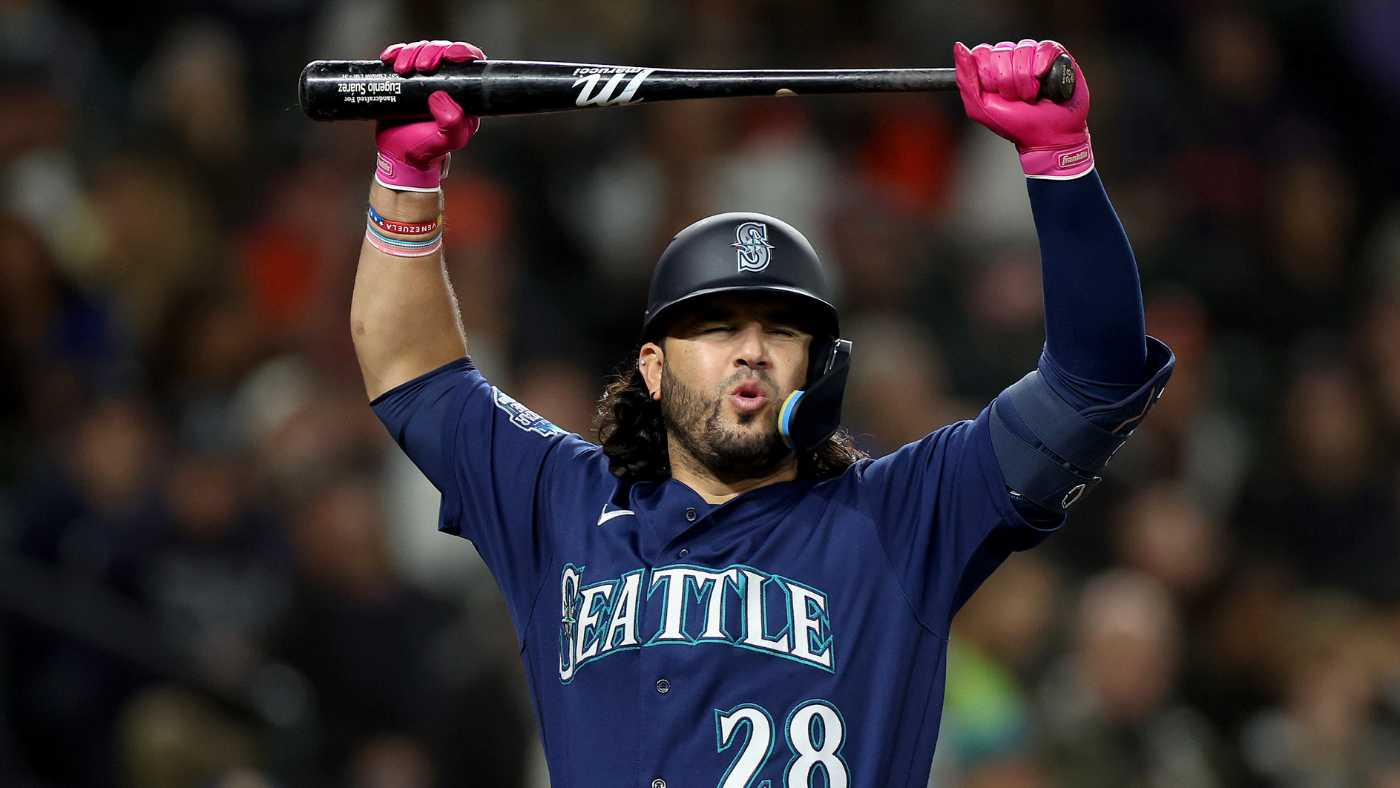MLB trends: Braves’ aggression, Mariners’ failed offseason gambit and Rockies’ stunning futility record
Written by CBS SPORTS ALL RIGHTS RESERVED on April 24, 2024

The 2024 MLB season is nearly four weeks old now, which isn’t so many games that we have to stop saying “it’s still early,” but it is also enough games that we can begin to read into a few things. With that in mind, here are a few early season trends worth knowing as we approach the end of April.
The ultra-aggressive Braves
Once again, the Braves sport one of the game’s top offenses. Last season they led baseball with 947 runs scored, 41 more than any other team, and they slugged .501 as a team. A player with a .501 slugging percentage had a great season. An entire team doing it is almost unfathomable. Yet Atlanta did it last season.
This season, the Braves are averaging an MLB-best 6.05 runs per game, a quarter of a run better than any other team. They are slugging a league best .471 as a unit, which is excellent despite being a step down from last year. The Braves have managed this even though reigning NL MVP Ronald Acuña Jr. has just one home run. Marcell Ozuna has been the star of the show. He’s been incredible.
The key to Atlanta’s success? Aggressiveness. To be sure, they make life tough on opposing pitchers and will grind out at-bats when the situation calls for it, but no team swings at the first pitch more than the Braves. They’re ready to attack from the very first pitch and they get results. Here are their numbers on the first pitch:
| Braves | MLB rank | MLB average | Next best team | |
|---|---|---|---|---|
Swings | 36.8% | 1st | 30.6% | Rangers (36.4%) |
AVG | .480 | 1st | .338 | Red Sox (.419) |
SLG | .847 | 1st | .558 | Red Sox (.802) |
OPS+ | 191 | 1st | 100 | Red Sox (166) |
Just to be clear, swinging at the first pitch in this instance includes every swing, not just balls put it in play. That means foul balls, swings and misses, the works. Take a pass at it, and it’s included here. In 36.8% of their plate appearances this season, the Braves took a hack at the first pitch, edging out the defending World Series champion Rangers for the highest rate in baseball.
Great, so the Braves are super aggressive. That means you start them out with a first pitch breaking ball out of the zone to use that aggressiveness against them, right? Well, sure, you can try, but the Braves have a 16.4% chase rate (i.e. swinging at a pitch outside the zone) on the first pitch. That’s only slightly higher than the 15.5% league average. They’re aggressive, but disciplined.
One through nine, the Braves have the deepest offensive attack in baseball, and there really is no good way to attack them. They’re ready to swing first pitch but they’ll also work a long at-bat if they don’t get anything to hit early in the count. It’s as well-rounded an offense as we’ve seen in several years. Right from the first pitch, the Braves are ready to do damage.
Seattle’s failed attempt to reduce strikeouts
The Mariners had an unusual offseason. They snapped their two-decade-long postseason drought in 2022, then fell a single game short of the postseason in 2023. Despite that letdown, ownership would not approve a payroll increase, ostensibly because of the uncertainty with their ROOT Sports broadcast deal. GM Jerry Dipoto had to get creative to reshape the roster.
Although it was never a stated goal, it was clear Dipoto and the Mariners sought to reduce strikeouts over the winter. Their hitters struck out in 25.9% of their plate appearances last season, the second-highest rate in baseball and well above the 22.7% league average. Dipoto then jettisoned almost all his high-strikeout hitters. Here are Seattle’s top 2022 strikeout rates (min. 200 PA):
- Mike Ford: 32.3% (non-tendered in November)
- Jarred Kelenic: 31.7% (traded in December)
- Teoscar Hernández: 31.1% (allowed to leave as a free agent)
- Eugenio Suárez: 30.8% (traded in November)
- Cal Raleigh: 27.8%
- Tom Murphy: 27.7% (allowed to leave as a free agent)
Raleigh is a cornerstone player behind the plate. You live with his strikeouts to get everything else he brings to the table at the game’s most demanding position. Everyone else was shown the door, either as free agents or via trade as a way to clear salary. Suárez was salary dumped on the Diamondbacks and Kelenic was used to unload Evan White’s and Marco Gonzales‘ contracts.
The Mariners did not skew heavily toward low strikeout hitters to replace Hernández, Kelenic, et al. New additions like Mitch Garver and Jorge Polanco are closer to average strikeout rate guys, ditto the returning Mitch Haniger. Luke Raley had a 31.5% strikeout rate a year ago, but you can tolerate one player like that. It’s a problem when you have 3-4 of those guys in the lineup regularly.
Surely those efforts have resulted in a lower strikeout rate in 2024, right? Nope. The Mariners are striking out even more in 2024. They have a team 26.9% strikeout rate, second highest in baseball and a percentage point higher than last year’s 25.9% rate. Garver and Polanco in particular have seen their strikeout rates jump in the early going.
The larger issue is not that the Mariners are striking out so much. It’s that they’re striking out so much and also not hitting for much power. That is usually the trade-off. You accept strikeouts when the player hits the ball out of the park consistently, like Hernández and Suárez. Even Ford slugged 16 home runs in only 251 plate appearances a year ago. Their whiffs came with power.
This year though, the Mariners rank 20th in home runs and 22nd in slugging percentage, and they did not score more than five runs until their 13th game. They’ve scored at least five runs in four of their last seven games, so things are trending up, though Seattle still ranks in the bottom half of the league in just about every important offensive category.
The season is still very young, so there’s plenty of time for the Mariners to get things back on the rails, but thus far what appears to be a concerted effort to reduce strikeouts has yet to yield the desired results. The offense has not yet perked up and the Mariners are striking out even more than they did a year ago. The intentions were good. The execution thus far is not.
The Rockies’ futility
The Rockies should send the White Sox a little thank you note, because Chicago’s futility is getting all the attention early this year. The 6-18 Rockies are flying under the radar. Their 18 losses are tied with the 2005 team for the most through 24 games in franchise history, and they somehow rank bottom in the bottom third of the league in runs per game despite playing in Coors Field.
Alright, so the Rockies are bad. We all expected that, right? Right. But there is something remarkable about how bad they’ve been. Case in point: Colorado has trailed at some point in every single game they’ve played this year. All 24 games. Not even the White Sox can say that. Chicago managed to never trail against the Braves of all teams in a 3-2 win on April 2.
All six of the Rockies’ wins are come-from-behind wins, the most notable of which was turning a 4-1 fourth inning deficit into a 7-5 win over the D-Backs and Zac Gallen on April 8. Colorado scored two runs in the fourth and three runs in the sixth to swing that game. Here are those rallies:
On Monday, the Rockies became the first team to trail in each of their first 23 games since the 1931 Reds. The 1931 Reds never trailed in their 24th game. They scored five runs in the first inning against Brooklyn Robins righty Dolf Luque and never looked back.
The Rockies trailed again Tuesday night. They were down 1-0 to the Padres three batters into the game. That made them the first team to trail in each of their first 24 games since the 1910 St. Louis Browns, who trailed in each of their first 28 games. Every single night the Rockies are playing from behind. Hard to win in this league that way.
The bad teams are as bad as ever these days. As recently as 2018, we had never seen four 100-loss teams in a single season, then it happened in 2019, 2021, 2022, and 2023. The Rockies stand as good a chance as team to lose 100 games this year. For now, they can’t even play a single game without trailing. Every night they look up, and they’re behind on the scoreboard.
The post MLB trends: Braves’ aggression, Mariners’ failed offseason gambit and Rockies’ stunning futility record first appeared on CBS Sports.






